If you’re involved in SEO, you’ve likely heard of buyer intent keywords. These are keywords that searchers use when they are close to purchasing.
Optimizing your site for buyer intent keywords is essential for increasing sales. And there are lots of buyer intent keywords that are easy to rank for.
In this article, you’ll learn how to find and optimize buyer intent keywords for your small business WordPress site.
But first, let’s gain a better understanding of buyer intent keywords.
In This Article
Understanding the Intent Behind Keywords
When a searcher types a query (i.e., keyword) into Google or speaks it into a voice-activated device, the words they use signal intent.
This is called search intent, but perhaps searcher intent would be a better term.
Sometimes, the intent is vague. For instance, if someone searches for “tacos,” do they want to find a Mexican restaurant? Taco recipes? Or something else?
The more specific a keyword is, the clearer the intent is.
Here are some examples of specific search queries. Can you guess the searcher’s intent?
- Pizza delivery near me
- 24-hr plumber to fix frozen pipes
- How to make Korean tacos
- Watch Finland vs Kazakhstan UEFA
Specific keywords are also called long-tail keywords. And often, the more specific the keyword, the easier it is to rank for.
What Are Buyer Intent Keywords?
Some long-tail keywords signal the searcher is interested in buying a product or service. They may compare brands and prices or look up discount and delivery information.
Examples of these keywords are:
- Cheap car insurance quotes no deposit
- Best budget leaf blowers
- Dropbox vs. PandaDoc
- Affordable wedding videographers
Why Use Buyer Intent Keywords?
When you create content designed to rank high for buyer intent keywords, you’ll attract qualified prospects.
Contrast that with ranking well for vague keywords (like “insurance”) that don’t signal buying intent.
Now, it’s true that targeting vague keywords may result in significant traffic increases. But typically, the conversion rate will be low.
In addition, it’s tough to rank for broad keywords. You’ll wind up spending more to achieve less. And that will drive up the cost of customer acquisition.
Ranking for the right keywords is more important than total traffic.
So, to get the most ROI for your SEO, create content that targets buyer intent keywords. This traffic will drive conversions and sales.
Long-Tail vs. Short-Tail Keywords
Now, let’s clarify some terms.
Short-tail keywords:
- Also known as “head” or “generic” keywords
- Typically consist of one or two words
- Broad and general in nature
- Example: “shoes,” “laptops,” “travel”
Long-tail keywords:
- Comprise three or more words
- More specific and targeted
- Reflect a user’s specific intent or query
- Example: “running shoes for flat feet,” “best budget gaming laptops,” “family-friendly vacation spots in Europe”
So, the goal is to find long-tail keywords that signal buying intent.
But how can you figure out the intent? Let’s find out.
Keyword Intent Labels
Keyword research tools like Semrush and Ahrefs label keywords by intent.
- I is for Informational: The searcher is gathering information and often has no buying intent.
- N is for Navigational: the intent is to find a particular product or website (e.g., “in-and-out burger”)
- C is for Commercial: the searcher typically compares and considers products, often to buy in the near term. These searchers may also be trying to solve a problem and searching for “How-to” content.
- T is for Transactional: the searcher is on the brink of buying. These searches may include terms like “best,” “budget,” “discount,” or “free shipping.”
| Keyword Type | Benefits |
|---|---|
| Buyer Intent Keywords (Commercial or Transactional) | — Less competition compared to broad keywords, therefore easier to rank for. — Draws traffic with a higher likelihood of making a purchase. — Helps SEO efforts by improving the website’s SERP ranking. |
| Broad, Informational Keywords | — Able to draw a large volume of traffic due to wide usage. — Many Informational keywords are hard to rank for. — Useful or increasing overall site visibility and brand awareness. — Helps establish website as a valuable resource for information. — Could lead to sales indirectly by nurturing customers through the buying process. |
Now that you know how keywords are labeled, how do you find the right ones for your business or the buyer intent keywords?
How to Find Buyer Intent Keywords
The 1st step in finding buyer intent keywords is to brainstorm.
Step 1: Brainstorm
Jot down common problems that your product or services solve for prospects. Why do customers choose you? What’s special or unique about your business? Do you offer lower prices, higher quality, or free shipping?
For our tutorial, we’ll use the example of a fictitious business that sells wood flooring. This company offers all standard wood flooring types and sells exotics like teak, cypress, mahogany, and rosewood.
We’ll start by researching “wood flooring.”
Step 2: Create a Semrush Account
First, create a Semrush account. You can sign up for a 7-day free trial and cancel anytime.
This is the tool we’ll use to do keyword research.
Step 3: Enter a Keyword into Keyword Overview
Now, open Semrush and click Keyword Overview in the left-hand column.
In the blank field, we enter “wood flooring.”
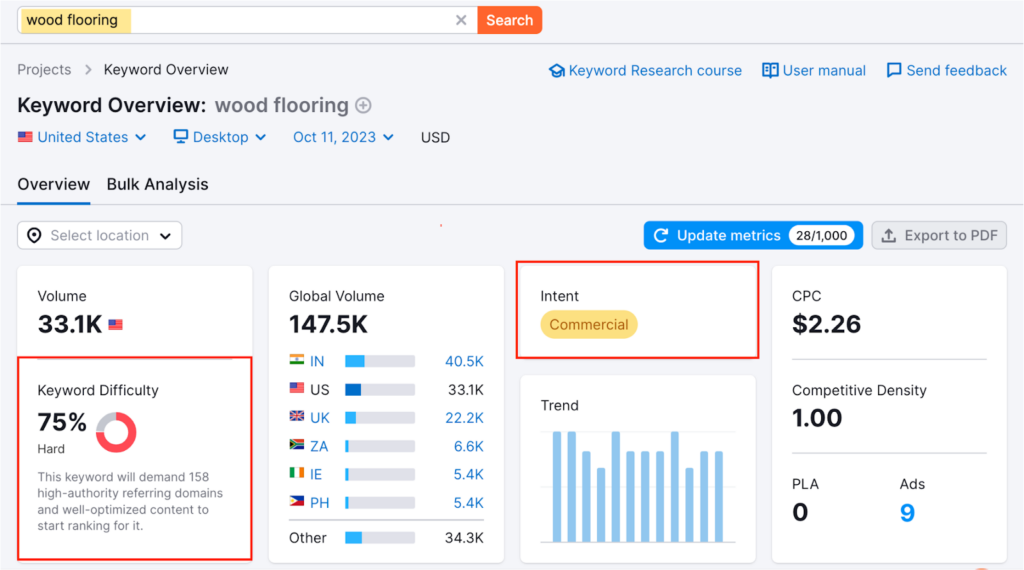
Each keyword in Semrush has a Keyword Difficulty (KD) score. Here, we see the Keyword Difficulty is 75% or “Hard.”
If you’re just starting with SEO, you want to avoid these hard-to-rank keywords.
Can we find some low-competition keywords that are easy to rank for and have commercial or transactional intent?
Step 3: Find Easy Keywords with Commercial or Transactional Intent
Simply click the Keyword Magic Tool in the left-hand column. Now, we have over 168k related keywords.
We’ll sort these by clicking on the KD (Keyword Difficulty) column twice. Now, the keywords will appear in order of low to high difficulty.
We see many keywords related to product size, like these rated “C” for commercial intent and having a KD score of zero.
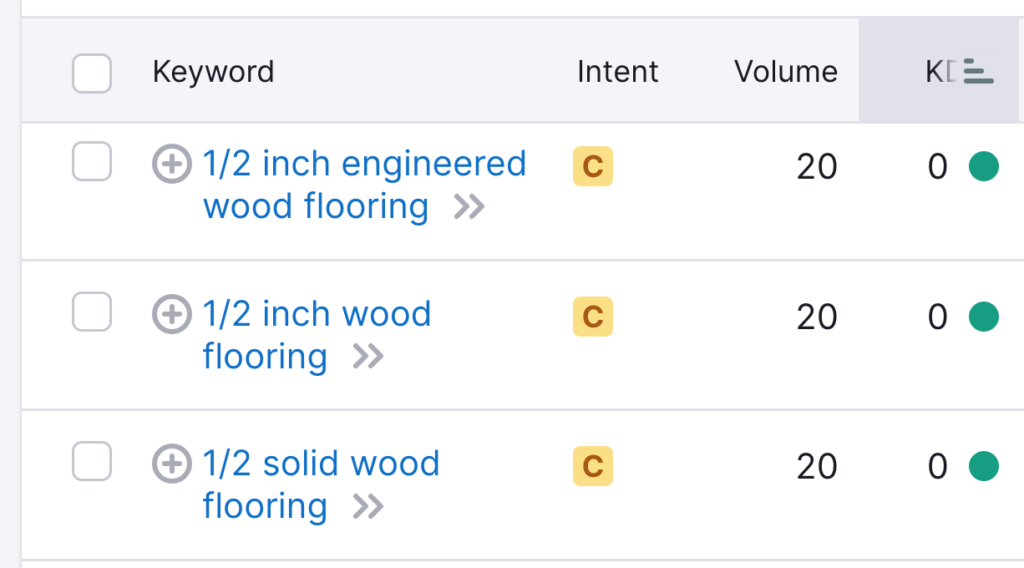
There are also easy-to-rank keywords that include the type of wood.
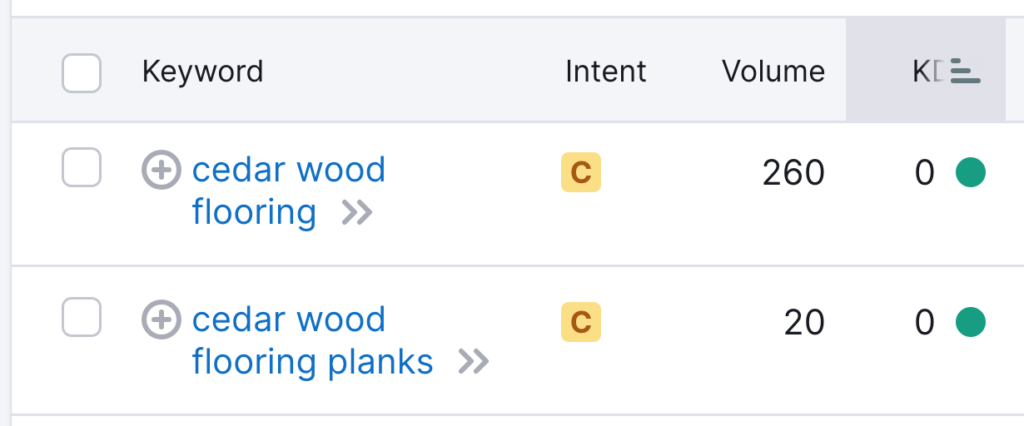
We started with an overly broad keyword: “wood flooring.”
Because we don’t want to sort through 168k options, we’ll return to the Keyword Overview and enter one of our specialty products: “Brazilian rosewood flooring.”
This keyword is rated 0% (the easiest to rank for), and it’s labeled commercial.
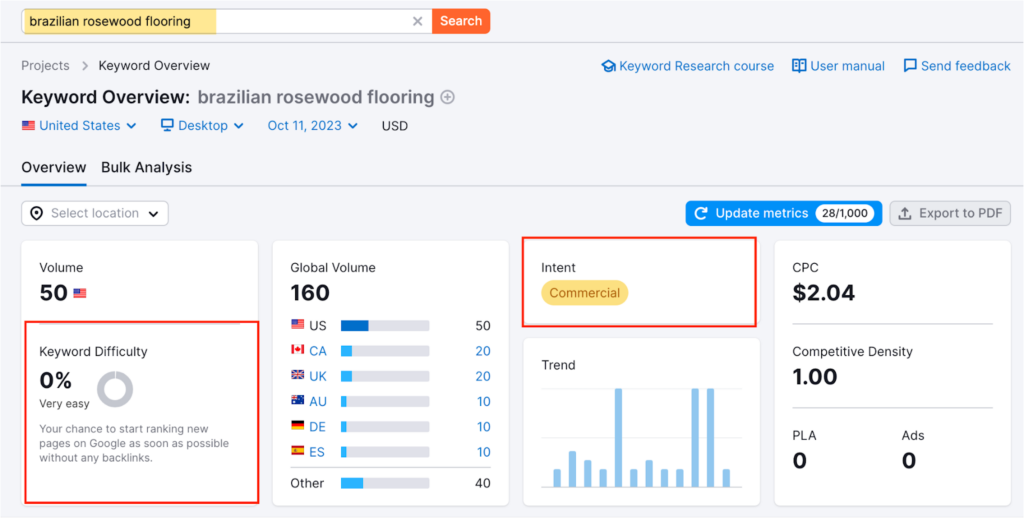
In addition, the related keyword “exotic wood flooring” is also rated “Easy,” and it has commercial intent.
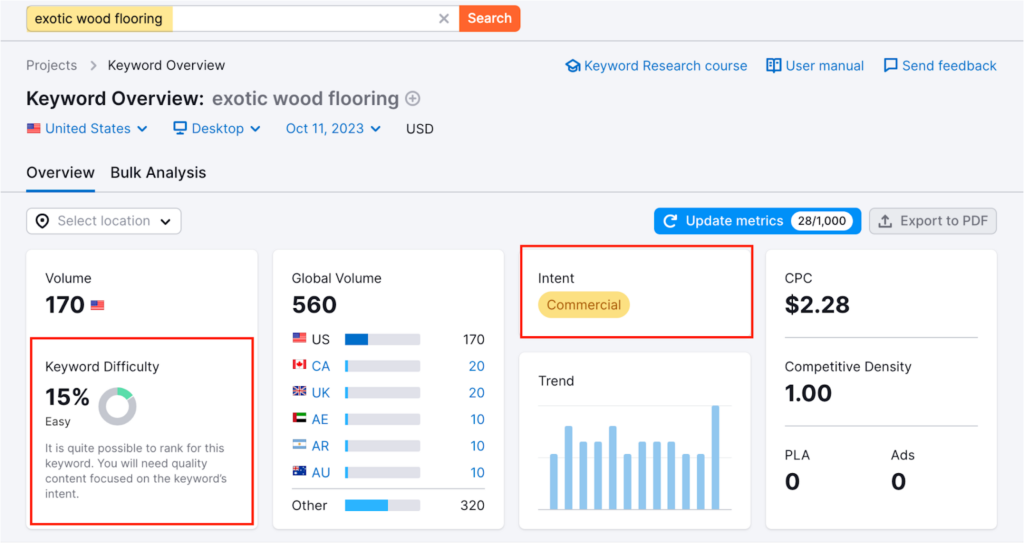
We decide to create a summary page on our “exotic wood flooring.” This page will link to individual pages covering specific exotics, like “Brazilian rosewood flooring” and “Brazilian teak flooring.”
By focusing on keywords that are easy to rank for and rated commercial, we can start attracting buyers as we improve our overall site ranking.
Now that we know how to find buyer intent keywords that are easy to rank for, there are a few more things to keep in mind.
Topic Clusters
The approach we’re using, creating a summary page and linking out to detailed pages, can also help us rank.
Marketers call this building “topic clusters.” It sounds fancy, but it’s just an organized way to create content to accelerate your ranking.
Learn more in our how-to guide on topic clusters.
Let’s look at a few more ideas for creating compelling content on buyer intent keywords.
Ideas for Using Commercial and Transactional Keywords
Comparison articles and reviews: Searchers who use commercial keywords are researching their options. They will compare products, features, and pricing.
So why not help them by creating comparison reviews? Our SEO Secrets guide shows you how to do that.
Since these searchers often use terms like “best,” consider writing showcase articles featuring your brand and several competitors.
Here are some examples.
- 8 Best Anti-Spam Contact Forms for WordPress
This review, by WPForms, compares their product to 7 competitors. - Best Budget Turntables
LouderSound.com provides 8 recommendations, each with an affiliate marketing link. - 8 Best SEO Chrome Extensions to Simplify Your Workflow
This article features the AIOSEO Analyzer Chrome extension and 7 competitors.
How to Optimize Buyer Intent Content for Maximum Reach
Once you finish creating your content, you’ll want to optimize it for maximum reach.
This is where All in One SEO (AIOSEO) comes in. All in One SEO will analyze your content and provide specific steps to improve SEO. This takes a lot of the guesswork out of SEO.

After you download and install AIOSEO, a setup wizard will walk you through a few short steps.
Then, while logged into WordPress, navigate to a page you want to optimize.
Click the AIOSEO button at the upper right to open the AIOSEO sidebar.
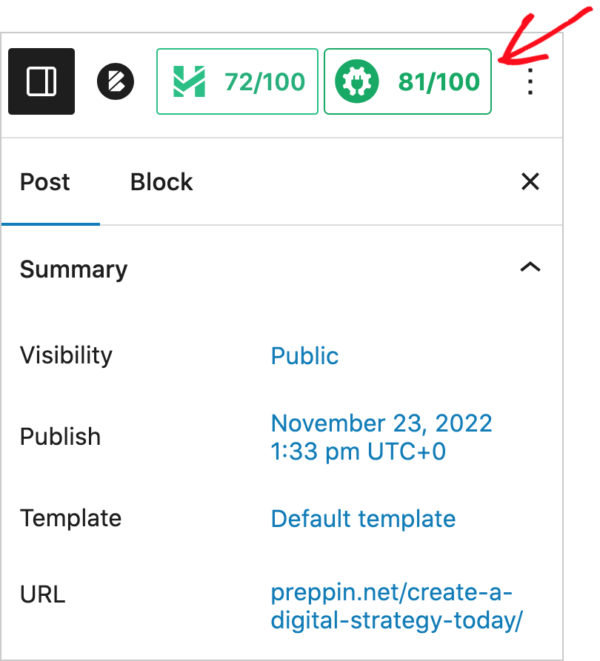
Then click General.

You’ll find recommendations sorted by Focus Keyphrase, Basic SEO, Title, and Readability.

The plugin will show you what you’ve done well.
And what could use some improvement.
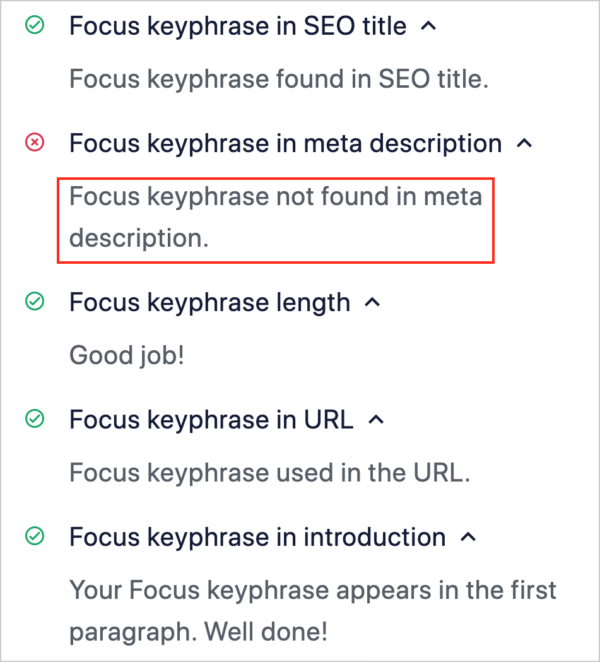
We run all of our content through AIOSEO before publishing. Acting on the plugin’s recommendations takes us about 5-10 minutes. We credit it with helping us score page #1 placements in Google, featured snippets, and People Also Ask questions.
In turn, our improved SEO fuels our business growth.
All in One SEO (AIOSEO) is an established plugin with thousands of 5-star reviews on WordPress.org. Currently, over 3 million people use the plugin to optimize their sites.
Q&A on Targeting Buyer Intent Keywords
Now that you understand buyer intent keywords and how to find and select them, you may have some remaining questions.
We’ve answered a few below. If you have additional questions, please add them to the comments below this article. We’d be delighted to be of assistance.
What are high buying intent keywords?
Sometimes, “high intent” and “buying intent” are used interchangeably. While there are variations in how marketers define these terms, we define buying intent keywords as those having either commercial or transactional intent.
Keyword research tools like Semrush label keywords as commercial or transactional. Commercial intent means the searcher is considering a purchase. Transactional intent means the searcher is on the brink of buying.
Are buyer intent keywords hard to rank for?
Because buyer intent keywords are specific, they’re often (but not always) easier to rank for than broad keywords.
Buyer intent keywords all have individual keyword difficulty scores. For example, “buy gold” is rated “Difficult” to rank for, and “buy gold ring” is rated “Possible.” Using a tool like Semrush or Ahrefs, you can discover the score for the keyword you want to rank for.
These tools also provide an easy way to find buyer intent keywords that are easy to rank for.
What’s more important: targeting high search volume or targeting buyer intent?
While marketers may disagree on this question, our position is targeting buyer intent is more important than targeting high search volume. You don’t need a lot of traffic to generate revenue if you target commercial or transactional keywords.
By contrast, many broad (called “informational”) keywords are difficult to rank for and have no buying intent. So, it takes more resources to rank for those keywords, and conversion rates may be disappointing.
That said, search volume and keyword intent are not mutually exclusive. So you can choose, among several possible buyer intent keywords, to cover those with the highest search volume. Don’t forget to check keyword difficulty scores, though.
After Buyer Intent Keywords . . .
Now that you understand buyer intent keywords, what’s next?
- Explore Topic Clusters: the SEO Secret Weapon.
- Discover 3 competitive SEO strategies to help your small busines srank.
- Steal our SEO Secrets the Pros Use to Grow Revenue.
- Learn to use content gap analyses to obtain competitive advantage.
- And be sure you’re ready to capture leads.
Subscribe to our YouTube Channel. You’ll enjoy the straightforward WordPress tutorials. You can also follow us on X (Twitter), LinkedIn, or Facebook to stay in the loop.
Disclosure: Our content is reader-supported. This means if you click on some of our links, then we may earn a commission. We only recommend products that we believe will add value to our readers.


Thank you very good service.